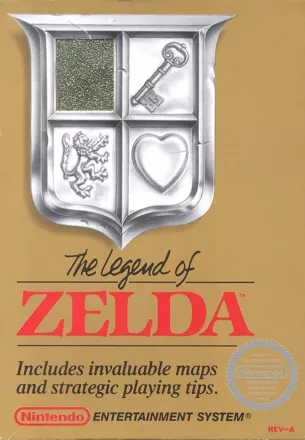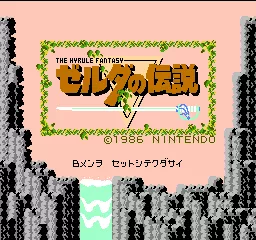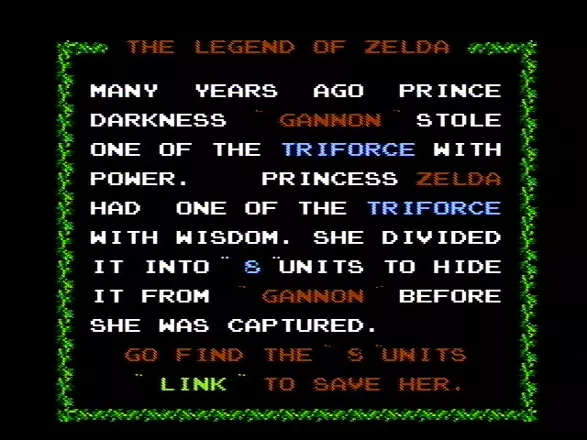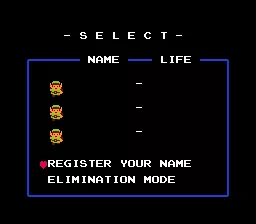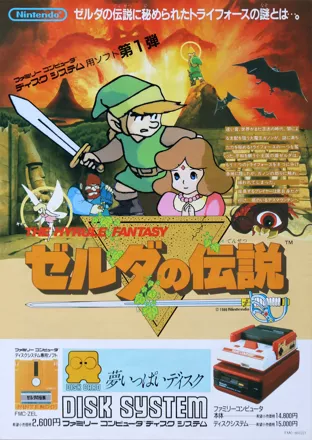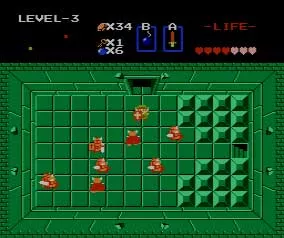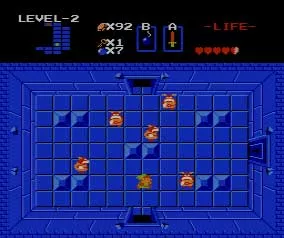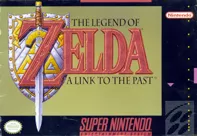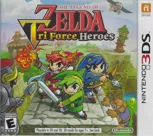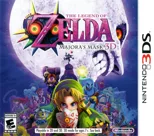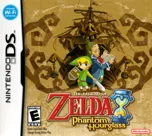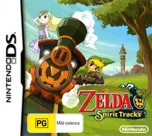The Legend of Zelda
Description official descriptions
In one of the darkest times in the Kingdom of Hyrule, a young, pointy-eared boy named Link takes on an epic quest to restore the fragmented Triforce of Wisdom and save the Princess Zelda from the clutches of the evil, power-hungry Ganon.
The Legend of Zelda marks the first title of the Zelda series. Players must make their way through the various forests, graveyards, plains, and deserts of the Overworld to find the secret entrances of the eight dungeons in an attempt to piece together the broken Triforce. Once all pieces are joined, Link will be able to gain entry to Death Mountain, home of Ganon, and prison of Princess Zelda.
The game is drawn in a top-down perspective. Link begins his quest in the Overworld, which features forests, mountains and lakes and is divided into several screens. Link can explore the Overworld freely, though when he enters a screen, he will encounter several enemies. He can attack them with his sword. If Link is at full health, he can toss his sword to attack enemies from afar, but when he is hurt, even slightly, he can only fight in melee range.
Link's health is represented by hearts; initially he can have a maximum of three hearts, but as he progresses in the game, he will find heart containers that increase his maximum health. The enemies are varied - some attack from up close, some shoot projectiles. When killed, they often leave behind an item - a heart to restore energy, rupees that function as money (and can be used to buy stuff in various shops in the Overworld), or bombs which can be picked up and set down to attack enemies or destroy some walls. Some items function as weapons or armor, while others are used to solve puzzles. When enemies are killed, they stay dead and will not re-appear once the screen is entered again.
To find the Triforce pieces, Link must explore dungeons. Once he finds an entrance to the dungeon and goes in, he must explore the rooms, fight enemies and collect keys until he finds the boss monster he must defeat. He will then be able to pick up a Triforce piece and gain a permanent health increase. Once he does so, however, all the monsters in the Overworld come back to life.
If Link dies on his quest, he can continue it; he will go back to his start position in the Overworld (or the entrance to a dungeon), but with the items he managed to collect so far. When Link finishes his quest, the player can choose to play the "second quest", which is essentially a harder version of the game.
The Legend of Zelda is known for several factors that were advanced at the time: a continuous world that could be freely explored, power-ups that would permanently enhance the main character's abilities, and a battery back-up save feature that allowed players to retain their progress instead of having to start over. The gameplay balanced out frequent action sequences with discovery, secrets, and exploration.
Spellings
- ゼルダの伝説 - Japanese Famicom Disk spelling
- ゼルダの伝説1 - Japanese Famicom Cartridge spelling
- 젤다의 전설 - Korean spelling
Groups +
Screenshots
Promos
Videos
Add Trailer or Gameplay Video +1 point
See any errors or missing info for this game?
You can submit a correction, contribute trivia, add to a game group, add a related site or alternate title.
Credits (NES version)
7 People
| Executive Producer |
|
| Producer |
|
| Director |
|
| Designer |
|
| Programmer |
|
| Sound Composer |
|
Reviews
Critics
Average score: 85% (based on 60 ratings)
Players
Average score: 4.0 out of 5 (based on 298 ratings with 15 reviews)
The Good
The Legend of Zelda was created by Shigeru Miyamoto and Takashi Tezuka. It is an action-adventure game viewed from a top-down perspective, and it was the first of its kind. The game was only available for the NES, so having owned a Commodore 64 meant that I had to miss out on how great this game was when it was released.
There is one thing that I really love about this game, and that is exploration. The ultimate goal is to recover each piece of the Triforce of Wisdom, which Princess Zelda broke into fragments when she was kidnapped by Ganon. As Link, you go exploring forests, mountains, graveyards, and the like fending off Ganon's henchman and obtaining items that will help you on your quest. By killing certain monsters, you get a certain number of Rupies, which you can use to buy equipment such as potions, weapons, shields, and whatever items are required later in the game.
Hyrule is divided into two parts. The Overworld is where you spend the majority of the game, and it is here that you are free to explore the sights, obtain equipment and discover many secrets along the way. The underworld mainly consists of dungeons, where you have to retrieve one part of the Triforce. The dungeons themselves are laid out nicely, and by getting the map somewhere within you can see what shape they form. Level Five, for instance, looks like a lizard. There is a certain strategy in defeating certain bosses, and you will see the same ones in later dungeons.
The graphics are great, and the animations of the different monsters are smooth. The screen is laid out nicely, with the top half reserved for the map and several stats, and you will be referring to it more often than not. I like how the inventory appears, appearing from the top of the screen and moving into the center. All your special attacks appear as icons and laid out nicely next to each other. You don't need to press a button on the gamepad to get it into the special attack box. As soon as you move the cursor over it, it is automatically selected, ready to use.
A lot of music is brilliantly composed, but the one most memorable can be heard as you walk around the Overworld. A few sound effects, like the throwing of Link's sword and defeating a monster, sounds excellent. Also, letting the player know when a boss is nearby - with a "roar" sound - is a stroke of genius. (You even hear him when you access your inventory.)
Opening up the box reveals a huge map of Hyrule that players need to refer to if they don't want to get lost. The map goes beyond an A4 sheet, so virtually impossible to photocopy it without great difficulty. It also includes an instruction booklet the game asks you to refer to after you read the brief summary. The booklet is also quite colorful and is worth reading more than once.
One of the other things I like about Zelda is that it can be replayed over and over again, and it is a game that you won't get tired of playing, because you can discover new things that you previously missed. Once you defeat Ganon and rescued Zelda, you have the option of playing “The Second Quest”, basically the same game but the locations are slightly different and the difficulty goes up a notch.
Unlike most NES games that I played so far, Zeldauses a save game feature, which allows players to save their progress rather than start over. This feature is advanced for its time. Another advanced feature is the use of power-ups that enhance the player's abilities.
The Bad
Some reviewers here states that The Legend of Zelda is very difficult, and allow me to provide an example of this. On the very first screen you start on, you go into this cave to get a sword that you can shoot beams out of. But this only applies if you have full health. Come into contact with the monster, and you lose that ability, with the gaming forcing you to come up close to the monster and strike him with the sword, meaning that it is more likely that you lose more health by doing so. Also, you can spend rubies on new weapons or upgrades to existing weapons, but not one of these more advanced weapons is effective on the most powerful monsters.
The Bottom Line
The Legend of Zelda received special treatment over others as not only did it include a huge map and a colorful instruction booklet, but it also came with a gold cartridge. The game has everything that I like - exploration, fantasy, combat, and replayability. Most of Zelda is either spent exploring every inch of Hyrule, going in caves and buying stuff or upgrading weapons, or entering a series of dungeons and stealing one of the Triforce pieces back. The game gets more difficult as you progress, and the music and sound effects are nice to listen to. I am looking forward to playing the next Zelda game, whatever it is called.
NES · by Katakis | カタキス (43091) · 2015
A great replica of the classic NES masterpiece.
The Good
I liked that they brought back an old classic without trying to add to it or make it better because that never works. I like that they put this game on GBA because now I can play it anywhere.
The Bad
I didn't like the fact that it took them so long to put this game on GBA or any of the Gameboy systems.
The Bottom Line
The NES Classic, The Legend of Zelda, is a great replication for GBA. If you like any of the Zelda games, you'll love this one. The original is always the best, proven by this game. And now you can take it anywhere.
Game Boy Advance · by Dark Lord (31) · 2005
The Good
I find it pretty great how balance this game is compared to others that were released around this time. When you play games from other companies, I find it a little frustrating at how clumsy the balance of those games are. Games like Castlevania or Ninja Gaiden, while still good games, felt unbalanced at how difficult it is to stay alive. On the other hand, I feel like Zelda makes you feel more in control of that factor.
This is accomplished through the exploration aspect of the game. Unlike other games before it, where if you couldn't finish a level you just had to try and try again until you finally got it right. But in Zelda, if you can't finish a level you can go back to the overworld and possibly find a way to extend your life, or buy a better shield in order to return to the level and try again, but this time some factor of that level has changed which makes the game less frustrating to play though.
As I can't be totally sure of this since I haven't played every single game from around that time period, but all the games I played before that were based on "make it through the level" and your difficulty factors were either a time limit, killing a certain number of enemies, or finding keys. (which admittedly Zelda also does but the inclusion of Zelda's item system makes it more interesting.)
I will agree with some other negative reviews of this game that the graphics were very simple even for it's time, but I feel like this was done on purpose. The same reason that there wasn't a town with villagers that you could talk to. The fields were a solid bland color, all the dungeons are basically monochromatic, even the dungeon BGM is very repetitive. I get the feeling that these were mechanisms used to create the feeling of loneliness. Sure, there are some people in the game that sell you items, give you money, tell you a hint, or gamble with you, but the text is so sparse and robotic (again possibly on purpose) that it accurately conveys this sense of loneliness never felt in game worlds before.
The Bad
Some rooms in the later dungeons seem to only rely on throwing more baddies in there as a difficulty factor as opposed to finding a smarter way to create challenge. I also hate the way that they re-use bosses from earlier dungeons and just throw them into the later dungeons. Seems like they just wanted to get the game out so they started to recycle old content to push it out quicker.
The Bottom Line
Zelda is a game about accomplishment. Much like the early Metroid games, it's fun to play through and find an inaccessible area, find an item meant to reach that area, and then it clicks in your head. You really feel a sense of accomplishment when this happens because even though it is a video game and was definitely a pre-determined scenario (by the game designer), you feel much more like you found this item and thought up a really cool use for it as opposed to using it for more firepower or more life. That is really what made this game unique and why it was a pioneer for the industry.
NES · by Calpis (27) · 2008
Discussion
| Subject | By | Date |
|---|---|---|
| Not much fun to play now, except for seeing how it was a leading game in the action/RPG combination. | Andrew Fisher (697) | Mar 27, 2024 |
| Legend of Zelda tribute on MTV | Daniel Saner (3503) | Mar 14, 2011 |
| Super-epic orchestral take on Zelda music | J. P. Gray (115) | Jun 2, 2008 |
| RPG Controversy | SharkD (425) | Oct 31, 2007 |
Trivia
1001 Video Games
The NES version of The Legend of Zelda appears in the book 1001 Video Games You Must Play Before You Die by General Editor Tony Mott.
Cartoon
The Legend of Zelda was popular enough to have a TV cartoon based on it in the late 1980s-early 1990s. It was part of the Super Mario Bros. Super Show, and aired only on Fridays during its original run in the US.
Cartridge
The Legend of Zelda was the first NES cartridge was released with a shiny gold colored plating, breaking away from the usual gray color.
Cereal
The Legend of Zelda was popular enough to have a breakfast cereal based on the game called the "Nintendo Cereal System" and was co-packaged with Super Mario Bros. cereal. The sweetened corn bits were in the shape of Link, Link's shield, boomerang, key, and a heart.
Character names
- Link was named as such because of Shigeru Miyamoto's desire to "link" the player and the character together.
- Zelda was named as such when Miyamoto learned that F. Scott Fitzgerald's wife was named Zelda. Feeling that the name was appropriate, the princess was named Zelda.
Famicom Disk System
In Japan, The Legend of Zelda was the first original game released for the Famicom Disk System add-on, being the only launch title not previously released on cartridge. The Japanese cartridge version was not released until 1994, and was the very last first-party Famicom release. As there had been three sequels produced in the meantime, the cartridge version was titled The Legend of Zelda 1 to avoid
Innovations
In the United States, The Legend of Zelda was the first NES cartridge to include a battery-backed save feature.
Microphone
The instruction manual says that Pols Voice -- an enemy in the game that looked like a ghost with large rabbit ears -- "hates loud noises", although the flute item has no effect on it. This text actually refers to a microphone which was built into the Famicom's controller, but was not included in the NES; blowing or shouting into the microphone killed these creatures.
Sales
As of 2004, The Legend of Zelda has sold eight million units.
Version differences
A modified version of the game, complete with updated graphics, a smaller overworld, and completely different dungeons was released in 1995 for the Satellaview, the Super Famicom's (Japanese Super Nintendo) Japanese-only satellite-based add-on.
Called BS Zelda (the 'BS' standing for Broadcast Satellaview), several sources from Japan allude to this as being intended as a "third quest", much like the second quest accessed via the secret code.
When the game was 'rebroadcast' in 1996, Nintendo changed the map layout again. This revision apparently had a smaller broadcast audience than before, and is known only as "~map2~". This second map could again be thought of as a "fourth quest". Additionally, Link was replaced by the Satellaview mascots: A boy who wore a backwards baseball cap, and a girl who had red hair.
Awards
- Electronic Gaming Monthly
- November 1997 (Issue 100) - ranked #10 (Readers' Top 10 Games of All Time)
- November 1997 (Issue 100) - ranked #13 (Best 100 Games of All Time)
- February 2006 (Issue #200) - #5 on the "Greatest Games of Their Time" list
- Game Informer
- August 2001 (Issue #100) - #1 in the "Top 100 Games of All Time" poll
- October 2004 (Issue #138) - One of the "Top 25 Most Influential Games of All Time"
- GameSpy
- 2001 – #10 Top Game of All Time
- The Strong National Museum of Play
- 2016 – Introduced into the World Video Game Hall of Fame
Information also contributed by 雷堂嬢太朗 -jotaro.raido-, Big John WV, Captain Canuck, Guy Chapman, Indra was here, Maw, ModestMr.Green, Son of Kyuss and vedder
Analytics
Upgrade to MobyPro to view research rankings!
Related Sites +
-
Classic NES Series for the Game Boy Advance
Covers the line-up of the new Game Boy Advance series of NES Classics. -
LegendZelda.Net
Game-dedicated page for The Legend of Zelda. -
Links' Legends
A very informative site about the history of Link and Zelda games -
NES Manual
The complete manual for The Legend of Zelda is reprinted here -
OC ReMix Game Profile
Fan remixes of music from The Legend of Zelda. -
RPG Classics' Zelda shrine
Contains lots of useful information on this game, including maps, descriptions of items and enemies as well as complete walkthroughs. -
Zelda.Com
Nintendo's Official Website. -
Zeldapower.com Forums
Message board for all Zelda games
Identifiers +
Contribute
Are you familiar with this game? Help document and preserve this entry in video game history! If your contribution is approved, you will earn points and be credited as a contributor.
Contributors to this Entry
Game added by NetDanzr.
Nintendo 3DS added by ResidentHazard. Wii U added by Michael Cassidy. Wii, Game Boy Advance added by Guy Chapman. Nintendo Switch added by Kam1Kaz3NL77. NES added by Servo.
Additional contributors: PCGamer77, Jeanne, Guy Chapman, chirinea, Exodia85, NH, Alaka, monkeyislandgirl, samsam12, Zaibatsu, Patrick Bregger, sgtcook, Thomas Thompson, yenruoj_tsegnol_eht (!!ihsoy), FatherJack, firefang9212, SoMuchChaotix.
Game added February 24, 2001. Last modified February 16, 2024.
